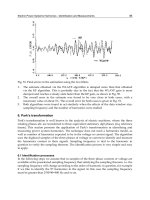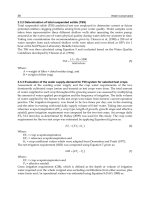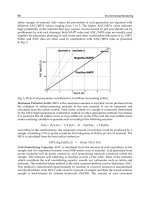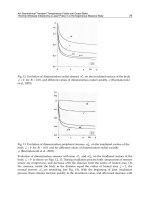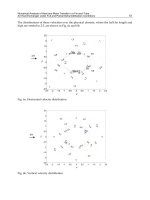Programmable Logic Controller plant through MMI Part 4 docx
Bạn đang xem bản rút gọn của tài liệu. Xem và tải ngay bản đầy đủ của tài liệu tại đây (614.82 KB, 13 trang )
Programmable Logic Controller
32
8. Acknowledgment
This research is financed by the ProViking research programme. Thanks also to all
concerned staff at the studied companies for sharing their knowledge and code. Thanks to
Isak Öberg and Olof Bergqvist for performing an interesting master thesis.
9. References
Olof Bergqvist and Isak Öberg. PLC function block survey of Swedish automotive industry.
Master’s thesis, Dept. Signals and Systems, Chalmers Univ. Technol., Göteborg,
Sweden, 2007.
B. Bérard, M. Bidoit, A. Finkel, F. Laroussinie, A. Petit, L. Petrucci, Ph. Schnoebelen, and P.
McKenzie. Systems and Software Verification – Model-Checking Techniques and Tools.
Springer, 2001.
Edmund M. Clarke, Orna Grumberg, and Doron A. Peled. Model Checking. MIT Press, 2000.
Georg Frey and Lothar Litz. Formal methods in PLC programming. In Proc. Int. Conf. Syst.,
Man, Cybern., pages 2431–2436, Nashville, TN, USA, 2000.
IEC. Programmable Controllers—Part 3: Programming languages. International standard
IEC 61131-3. International Electrotechnical Commission, second edition, 2003.
Dick Johnson. Nano devices lead assault on traditional PLC applications. Control
Engineering, 49(8):43 44, 2002.
Seungjoo Lee, Mark Adam Ang, and Jason Lee. Automatic generation of logic control.
Technical report, Ford Motor Co., Univ. of Michigan and Loughborough Univ.,
2006.
Robert W. Lewis. Programming industrial control systems using IEC 1131-3 Revised edition.
The Institution of Electrical Engineers, 1998.
Robert W. Lewis. Modelling Control Systems Using IEC 61499. The Institution of Electrical
Engineers, 2001.
Oscar Ljungkrantz and Knut Åkesson. A study of industrial logic control programming
using library components. In Proceedings of the 3rd Annual IEEE Conference on
Automation Science and Engineering, pages 117–122, Scottsdale, AZ, USA, 2007.
Oscar Ljungkrantz, Knut Åkesson, and Martin Fabian. Formal specification and verification
of components for industrial logic control programming. In Proceedings of the 4th
IEEE Conference on Automation Science and Engineering, pages 935– 940, Washington
DC, USA, 2008.
M.R. Lucas and D.M. Tilbury. A study of current logic design practices in the automotive
manufacturing industry. Int. J. Human-Computer Studies, 59(5):725–753, 2003.
Kenneth L. McMillan. Symbolic Model Checking. Kluwer, 1993.
Kenneth L. McMillan. The SMV language. Cadence Berkeley Labs, 1999. URL
Mostafa G. Mehrabi, A. Galip Ulsoy, and Y. Koren. Reconfigurable manufacturing systems:
Key to future manufacturing. J. Intelligent Manufacturing, 11(4):403–419, 2000.
David Lorge Parnas. On the criteria to be used in decomposing systems into modules.
Communications of the ACM, 15(12):1053–1058, 1972.
Johan Richardsson and Martin Fabian. Modeling the control of a flexible manufacturing cell
for automatic verification and control program generation. J. of Flexible Service and
Manufacturing, 18(3):191–208, 2006.
3
Control and Plant Modeling for Manufacturing
Systems using Basic Statecharts
Raimundo Moura
1
and Luiz Affonso Guedes
2
1
Federal University of Piaui – UFPI
2
Federal University of Rio Grande do Norte – UFRN
Brazil
1. Introduction
Based on the IEEE Standard Glossary of Software Engineering Terminology (IEEE Std
610.12-1990, 1990), “a system can be regarded as a collection of components organized to
accomplish a specific function or set of functions”. The key point in this definition is the
interaction among system components. Cassandras & Lafortune (2008) discuss systems
classification, especially for Discrete Event Systems (DES). In their definition, DES are
systems that have discrete state space and an event-driven dynamic, i.e., the state can only
change as a result of instantaneous events occurring asynchronously over time. In this
context, state-based methods such as Finite State Machines (FSM) and Petri Nets have been
traditionally used to describe these systems.
The automation area uses concepts of the theory of systems to control machines and
industrial processes. Considering an industrial automation process based on Programmable
Logic Controllers (PLC), the sensors are installed in the plant and generate events that
represent input variables to the PLC. The actuators are associated with the actions produced
by the PLC program and represent output variables. Industrial controller programming is
currently performed by qualified technicians using one of the five languages defined by
IEC-61131-3 (1993) standard and who seldom have knowledge of modern software
technologies. Furthermore, controllers are often reprogrammed during plant operation life-
cycle to adapt them to new requirements. As a result, “for practically no implemented
controller does a formal description exist” (Bani Younis & Frey, 2006). In general, PLC are
still programmed by conventional “trial-and-error” methods and there is no written
documentation on these systems.
On the other hand, software reusability and composability have been discussed since the
80’s, with the use of object-oriented methods (Boehm, 2006). In the Industrial area, the IEC-
61499 (2005) standard allows reuse of application parts (function block, sub-application) in
different applications. Software reuse is a complicated problem and depends not only on the
means provided by the modeling language, but also on the overall application structure.
In the Computer Science area, several models guide the software development process such
as the Waterfall Model (Royce, 1970), a sequential software development model in which
development is seen as sequence of phases; the Spiral model (Boehm, 1988), an iterative
software development model which combines elements of software design and prototype
stages; and agile methods, which emerged in the 1990. Examples of the latter are: Adaptive
Programmable Logic Controller
34
Software Development, Crystal, Dynamic Systems Development, eXtreme Programming (XP),
Feature Driven Development, and Scrum. B. Boehm (2006) presents an overview of the best
software engineer practices used since 1950 (decade to decade) and he identifies the historical
aspects of each tendency.
In short, an application life-cycle can be divided in three phases: Modeling - Validation -
Implementation (see Figure 1). Modeling is phase that demands more time in application
lifecycle. The “Modifications” arc represents multiple iterations that can occur in software
modeling processes. The “Reengineering” arc represents the research area, which
investigates the generation of a model from legacy code. Our focus is in forward
engineering, which investigate the model generation from requirements specified by users.
Fig. 1. Application life-cycle: overview.
In literature, there are several approaches that present methodologies, languages, and
patterns for modeling industrial applications, especially for Discrete Event Systems (DES)
(Cassandras & Lafortune, 2008). The two most common approaches are Finite State Machines
(FSM) and Petri nets; both allow for formal verification of the correctness of a control system.
However, despite significant research advances in recent years, these formal techniques
have not been widely employed in industry (Endsley et al., 2006). We believe that such
approaches are still low-level formalisms, resulting in large and unwieldy systems. The
Statecharts formalism, described by David Harel (1987), makes the specification and design
of complex DES easier. It extends conventional finite state machine with notions of
hierarchy, concurrency, and communication.
Owing to the aforementioned problems, this work discusses a methodology for plant and
control modeling and validating of the manufacturing systems that include sequential,
parallel and timed operations, using a formalism based on Statecharts, denominated Basic
Statechart (BSC). For the validation phase, simulations were executed through the
execution environment developed by the Jakarta Commons SCXML Project (SCXML, 2006),
and, as the control software model does not represent the controller itself, a translation from
this model into a programming language accepted by the PLC was also carried out. In this
study, Ladder diagrams were used because it is one of the languages defined by international
IEC-61131-3 standard most widely used in industry. However, these models can be
translated into any IEC-61131-3 standard language.
Control and Plant Modeling for Manufacturing Systems using Basic Statecharts
35
The remainder this work is organized as follows: Section 2 discusses about the main aspects
of the Statecharts in modeling of automation systems and we introduce the semantic of the
BSC using only characteristics relevant to the industrial area. Section 3 describes in general
the methodology proposed by this contribution. In Section 4, we discuss an algorithm for
translating the control model described in Basic Statecharts into Ladder diagrams, thereby
enabling tests with actual PLCs. In Section 5, one typical example of application in the
manufacturing area is discussed as case study to illustrate our ideas. In the last section, we
conclude with a discussion about future projects.
2. Basic statecharts
Automata-based methods have been widely used to model DES, especially by the
Supervisory Control Theory (Ramadge & Wonham, 1989). Automata represent mathematical
abstractions that explicitly enumerate all the states of the system. To construct complex
systems, the Automata are formally composed through systematic operations such as
product and parallel composition. Moreover, they facilitate the analysis of system properties
related to the validation and verification processes. However, the main drawback of the
approach is inherent in the graphic representation of the model, due to the exponential
growth of the number of states in the composition operations (Cassandras & Lafortune,
2008).
Statecharts formalism was described by David Harel in the 1980s and it extends conventional
automata with notions of hierarchy, concurrency, and broadcast communication. Thus,
Statecharts facilitate the specification and design of complex DES. Hierarchy and
concurrency are represented through OR-decomposition and AND-decomposition,
respectively. It is worth mentioning that Statecharts do not explicitly enumerate all the
system states. Therefore, an implicit combination of the parallel states must be performed to
obtain the real configuration of the model; that is, the real state of the system. Moreover,
Statecharts have a compact graphic representation that can be translated into automata,
according to the description in (Drusinsky & Harel, 1989).
The absence of a formal semantic of the original Statecharts makes the verification of these
models very complex to carry out. In an attempt to minimize this problem, several Statechart
variants were defined. Michael von der Beeck (1994) makes a comparison between 20
variants, and discusses a number of problems related to the original Statecharts. In addition,
the broadcast communication of the Statecharts allows a triggered event in one state to affect
another state that has no dependent relation with the former. Another drawback of the
original Statecharts is that they allow interlevel transitions without imposing any constraints,
a situation that can generate unstructured models.
To incorporate the advantages of the original Statecharts and to avoid the aforementioned
problems, we propose a formalism to model DES based on UML/Statechart diagrams, but
with a more limited syntax and semantic, denominated Basic Statechart (BSC).
The Basic Statecharts use the syntax of UML/Statecharts with some variations; for example: i)
absence of history connectors; ii) inclusion of input/output data channels to allow explicit
communication between the components and to avoid broadcast messages in the system;
and iii) the transitions are represented by the expression “[condition]/action”, where the
conditions are composed using variables, data channels and the logical operators AND, OR
and NOT; and, the actions allow one to change the value of these variables. The semantic of
Basic Statecharts is more restrictive than that of UML/Statecharts to avoid conflict and
Programmable Logic Controller
36
inconsistency in model evolution. We believe that this semantic is more appropriate for
modeling industrial systems.
A BSC is composed of a collection of components and a BSC component is a structure used
to model the behavior of a system element. A component can contain states, input/output
channels, internal variables, and other components, which can be called subcomponents. A
data channel is a resource used to communicate between system components. The input
data channels are implicitly associated with internal variables and thus their values are
maintained during the entire execution cycle. They can be used to change the value of guard
condition from the component or external entity, such as control software or a simulation
environment. The output data channels are also associated with internal variables;
however, their values are updated only at the end of the execution cycle. They are used to
publish the status of internal elements from one component to another.
The conceptual model describing the relationship between the elements that make up a BSC
diagram is shown in Figure 2.
Fig. 2. Basic Statecharts: conceptual model.
The evolution of the BSC dynamic behavior is performed by sequential steps, called the
execution cycle or macrostep. One constraint that is ensured by the BSC is that a component
composed of basic states can only trigger one transition in each execution cycle (macrostep).
As with original Statecharts, each macrostep in BSC can be divided into several microsteps;
however, the actions performed when one transition is triggered only update the variables
defined in the component data area. Moreover, the BSC run accordance with definition
order of the components. Thus, in an execution cycle only one component can affect the
components subsequently defined in the model. This point represents a difference between
the proposed approach and the Harel diagrams specified by UML. Basic Statecharts make the
definition of validation techniques more practical, because their syntax and semantic are
more constrained than those of the original Statecharts.
A macrostep of a BSC execution is finished when all the components have been analyzed.
The BSC communication mechanism follows a publish/subscribe pattern: the variables
associated to output channels are published in a global area, and the variables associated to
input channels are consumers of these data. It is important to note that a component can be
Control and Plant Modeling for Manufacturing Systems using Basic Statecharts
37
both publisher and subscriber of a same data item. However, the published value in one
step is only consumed in the next step. It is also valid for different components. Moreover,
one published value can be consumed by several components in a same step, but the value
of all components is guaranteed to be the same.
3. Plant and control: modeling and validation
In industrial applications, normally the controller software is verified in conjunction with a
model of the plant in which it operates. So, it is necessary to obtain an accurate model to
maintain fidelity with the real plant (relation one-to-one).
3.1 Plant: modeling
For plant modeling, our methodology is based on the hybrid approach - bottom-up and top-
down. More specifically, it proposes to model the basic elements, grouping them into larger
structures. This process is repeated until it generates the correct model of application. The
methodology consists of three phases described as follows:
1. Modeling the basic application elements or using models already defined in a
component repository;
2. Decomposing the basic states in substates, if necessary;
3. Representing all automation plant components as parallel states;
Phases 1 and 2 consist of modeling and refinements of the basic elements which compose
the application. They can be run several times as an iterative process. In each iteration, we
work with components which are more and more complex. Further, these components can
be grouped in a repository. The third phase determines that all application components
must be executed at the same time, in a parallel way, where the communication between
them is made by input/output channels.
We will present how our methodology works below.
3.1.1 Basic components: patterns
For automation systems, many components follow an On/Off pattern, for example, valves
and sensors. Figure 3-a shows the dynamic behavior of this pattern, which can be in states:
“Off” or “On”, and two transitions to change from state: “[g1]” from “Off” to “On” and
“[g2]” from state “On” to “Off”. Other components require adjustment in modeling to
include new characteristics. For example: a temporary state (Wait) between the states “On”
and “Off” (see Figure 3-b).
Fig. 3. On/Off patterns: basic model.
Programmable Logic Controller
38
3.1.2 Cylinder component
In the manufacturing field, one of the most common components is the pneumatic cylinder
that can be composed of more simple components (valves, arms and sensors) and can have
displacement sensors/end-position initiators.
Figure 4 depicts a single-action cylinder with advancing controlled by the valve, return
carried through springs, and one end-position sensor which is triggered when the cylinder
arm gets the full advance. The generic notation “[g]/A” in a transition means that: when a
guard condition g is true, the action A will be executed. Therefore, if an action in a
component X1 updating one variable used in guard condition of a component X2, then we
will say that: X2 depends on component X1. According to figure, the transition “[ch]/v1=1” and
“[v1]/tm1=1” indicate that: the cylinder arm depends on the valve, i.e., the arm advances
while the valve remains open. When the valve is closed through the action “ch=0”, the
cylinder arm gets “Returned”, in function of transitions “[¬v1]/tm1=0” or “[¬v1]/v2=0”.
The cylinder arm has the following behavior: when the variable v1 gets true, the arm gets to
“Advancing” in a specified time, which depends on technical characteristics and it is
represented by “*” in the figure. If the valve is closed before this specified time (event
tm1.tm), the cylinder arm gets to “Returned” and nothing happens to the sensor. If the event
tm1.tm occurs, then the arm gets to “Advanced” and the active state of the sensor passes
from “False” to “True”, implicitly. So, when the valve is closed, the arm gets “Returned”
and the sensor passes from “True” to “False”.
Fig. 4. Single-action cylinder: basic model.
The scenario that describes the desired operation of the cylinder is very simple: one external
event allows the opening of the valve when the channel gets equal 1 (ch=1); then the
transition “[ch]/v1=1” is run; and after the sensor detects the total advance of the cylinder-
arm, the valve must be closed (data channel equals 0, i.e., ch=0); then the transition
“[¬ch]/v1=0” is run. The events to open/close the valve represent the control police that is
run by the model and define the dynamic cylinder.
3.2 Control software: modeling
In the manufacturing area, actuator components are controlled through events that are
triggered by devices, such as buttons, sensors, and timers, which are defined in the control
model using temporary variables. The controller is modeled through the composition of
components; i.e., complex models are constructed from simpler models. The basic
Control and Plant Modeling for Manufacturing Systems using Basic Statecharts
39
components are: a) actuators that are modeled using components with two states: OFF and
ON; b) timers that are modeled using components with three states: OFF, START and ON -
the state “START” starts the timer and the transition “[tm1.tm]” from state “START” to state
“ON” triggers the end of the timer event; and c) variables that are associated with sensors
and temporary elements. Figure 5 shows the basic model for these elements. In this figure,
g1, g2, and g3 are guard conditions. The data model area in Figure 5-c defines two Boolean
variables (s1 and s2), both with the “false” value, using the syntax of the SCXML
specification that was implemented by the Jakarta Project Commons SCXML (SCXML, 2006).
This project provides a generic event-driven state machine based on the execution
environment, borrowing the semantics defined by SCXML, which represents the Statechart
diagrams by a XML file.
Fig. 5. Actuators: basic model.
Operational requirements of the actuators are inserted into the model as transitions between
the states, in the following general form: “[guard condition] / action”. The guard conditions
are Boolean expressions composed of data channel and internal variables, interconnected
through logical connectors ¬ (negation), || (disjunction) and & (conjunction). The actions
can be, for example, an assignment statement to set a value in the variable and/or data
channel. Therefore, operational requirements are constraints in the model to implement
dependencies and/or interactions between the components. Such constraints allow us to
define sequential and parallel behavior in the model; this will be described in the next
subsections.
3.2.1 Sequential operation
Consider a plant composed of two actuators (A
i
and A
j
) that run sequentially one after the
other, i.e., A
i
;A
j
. This sequence is run continuously in a cyclical way until user intervention.
The sequential behavior of A
i
and A
j
is obtained through the execution of actions in actuator
A
i
, which generates internal event triggers in actuator A
j
. In general, an action in an actuator
can cause state changes in other actuators.
Figure 6 shows the Basic Statechart diagram for modeling the sequential behavior between
actuators A
i
and A
j
discussed above. In this figure, ch
1
, ch
2
and ch
3
are input data channels;
ch
1
, A
i
and A
j
are output data channels, and “ev” is an internal variable. Note that a same
channel can be both input and output channel in a model. This is possible because the
channels are associated implicitly with internal variables. These elements are used to
generate the desired model behavior. In this case, the “ev” variable is used as an action by
actuator A
i
, which indicates the end of its actuation. It is perceived by actuator A
j
, which
starts its operation, generating the sequential behavior between them. Note that the data
Programmable Logic Controller
40
model area is not represented in the figure. At the end of A
j
actuation, data channel ch
1
is
updated, generating the cyclical behavior of the model. In its initial configuration, all the
actuators of the model are set to “Off”. The system starts its operation when data channel
ch
1
is equal to 1 (Boolean value “true”), a situation that can be simulated when the operator
pushes a “start” button on the Interface Human-Machine (IHM), for example.
Fig. 6. Control model: sequential operation.
3.2.2 Parallel operation
Parallelism, an inherent characteristic of original Statecharts, is accomplished through AND-
decomposition. However, the component synchronism demands additional mechanisms.
Consider a plant composed of three actuators (A
i
, A
j
and A
k
), where A
i
and A
j
run in
parallel, but A
k
can only run after the execution of the two first components, i.e.,
(A
i
||A
j
);A
k
. This sequence is run continuously in a cyclical way until operator intervention.
The parallel behavior of A
i
and A
j
is obtained naturally; however, internal variables must be
used to generate internal event triggers in actuator A
k
to indicate the end of execution in
other actuators. Thus, A
k
must wait for these updates to start its operation. After the A
k
run,
these internal variables must be updated to allow the execution of a new cycle in the system.
Figure 7 shows the Basic Statechart diagram for modeling the parallel behavior between the
aforementioned actuators. In this figure, ch
i
(i = 1 5) are input data channels, A
i
, A
j
and A
k
are output data channels, ev
i
and ev
j
are internal variables. These elements are used to
generate the desired application behavior. In this case, the variable ev
i
is updated as an
action by actuator A
i
, indicating the end of its actuation, and the variable ev
j
is updated to
indicate the end of A
j
actuation. These updates are perceived by actuator A
k
, which starts its
operation, generating the synchronism between them. At the end of A
k
actuation, the ev
i
and ev
j
must be “reset” to generate the cyclical behavior of the model. In its initial
configuration, the model must have all actuators set to “Off”.
3.2.3 Timed operation
Timers and counters are quite common in industrial applications; for example: i) an actuator
must execute for a specific time; ii) an actuator must execute only after a specific time; iii)
the system must execute k times before triggering an alarm; and so on. Timers and counters
are modeled through basic components and their current values can be used to set the guard
conditions of the transitions in BSC. Furthermore, they can be started and/or reset by some
action of the model.
Control and Plant Modeling for Manufacturing Systems using Basic Statecharts
41
Fig. 7. Control model: parallel operation.
Timers are controlled by a global real-time clock that executes in parallel to the system
model, and they are updated only at the beginning of each execution cycle. Thus, when a
timer is enabled in a component, the timing process is initiated in the next execution cycle.
When the timer reaches or surpasses its specified limit, an internal variable tm is made true
(tm = true) to indicate end of timing. In the timer, creating must define the time limit value
in time units.
Consider a plant composed of an actuator A
i
and a timer T
k
, where A
i
must act for t seconds
before turning off. Figure 8 shows the Basic Statechart for modeling the temporal behavior of
actuator A
i
, controlled by timer T
k
. In this figure, ch
1
and ch
2
are input data channels used to
start the operation of actuator A
i
and of timer T
k
, respectively, and tk.tm is an input data
channel used to indicate the timeout of T
k
. It is important to mention that the timers are
updated as a global action of the model, and the timer T
k
is started when action tk = 1 is
executed.
Fig. 8. Control model: timed operation.
Programmable Logic Controller
42
The guard condition “ev” used to turn off actuator A
i
becomes true when timer T
k
reaches
or surpasses the specified limit (condition tk.tm). Thus, the constraint that defines that
actuator A
i
must execute for a specific time is ensured.
3.3 Control software: validation
The approach for modeling the control software discussed in Section 3.2 maintains the
description and specification aspects built into the Basic Statechart model. Transitions, guard
conditions, and implicit actions are used to describe system constraints. Thus, the approach
allows us to analyze some controller properties using the reachability tree of the formal
model. Moreover, simulated environments can be used to validate the control model along
with the plant model.
The reachability tree of the model allows us to analyze a number of properties, such as: i)
reinitiability – for each cfg
i
state configuration reached from the initial cfg
0
configuration, is
it possible to return to cfg
0
by a sequence of events? ii) vivacity – does the controller act in
all of the components in the model? iii) deadlock – is there a cfg
i
state configuration in
which progress cannot be made because no transition can be triggered?
Masiero et al. (1994) propose an algorithm to create a reachability tree for Statecharts. Here,
we briefly discuss an adaptation of this algorithm to analyze the aforementioned structural
properties. This algorithm was implemented using Java language and the SCXML execution
environment, with the following modifications:
• The set that contains all possible transitions for a given configuration includes only the
transitions with events controlled by an external agent, and with timed events triggered
automatically by the components.
• To obtain a new configuration of the model by triggering a transition, the internal
variables are implicitly updated and, therefore, can trigger other transitions
automatically in the model. This characteristic decreases the number of states produced
in the reachability tree.
• The part of the algorithm that describes the history connectors is completely excluded,
because Basic Statecharts do not include such characteristics.
The use of this algorithm allows a formal analysis of system behavior (control + plant) to
verify and validate a number of properties. It is important to note that a plant model is
required, and it may be represented in a given formalism; for example, automata, Petri net
or Statecharts. Moura et al. (2008) propose a systematic procedure for modeling complex
plants using Statecharts and discuss some aspects of control modeling. However, they
presented only a descriptive view of that process.
In this work, we chose Basic Statecharts to model plant behavior, without losing generality.
Therefore, the system (control + plant) can be described as parallel composition between the
controller and plant. The main advantage of this approach is that sensor and actuator
characteristics become internal events of the system. Thus, the intrinsic properties of the
system, such as reachability, deadlock, and reinitiability become intrinsic and extrinsic
properties of the controller.
Another advantage of this approach owes to the fact that it maintains controller and plant
functionality explicitly separated. Here, unlike other approaches, such as the R & W
approach (Supervisory control), the controller synthesis produces more compact models. In
the next section we present an algorithm for translating the control model described in Basic
Statecharts into one PLC language (in this case, Ladder diagram).
Control and Plant Modeling for Manufacturing Systems using Basic Statecharts
43
4. Control software: implementation
Given that the control model does not represent the controller software itself, the translation
from this model into a programming language accepted by the PLC must also be performed.
Ladder diagrams were used because it is one of the languages defined by international IEC-
61131-3 standard most widely used in industry. The translation is performed systematically
by a method that analyzes one component at a time, according to its type (actuator or
timer).
The states (“OFF” and “ON”) in the actuators are represented in the Ladder through
auxiliary contacts (flip-flop Reset and flip-flop Set), respectively. Each control model transition
results in a “rung” of the Ladder, as follows: the source state must be added to the condition,
and the target state represents the action that must be executed. Let A be the generic
actuator shown in Figure 5-a, where transitions “[g1]/A=1” and “[g2]/A=0” generate lines 3
and 4, respectively, of the Ladder diagram, as shown in Figure 9. In this figure, c1, c2, and c3
are auxiliary variables that are computed from the guard conditions of the model (i.e., g1,
g2, and g3, respectively). This mapping is made because the guard conditions can be
complex.
The timers were translated as follows: one “rung” to transition from the “OFF” to “START”
state, which allows us to start up the timing; one “rung” to specify the timer itself, with one
element that indicates the end of the specified time, which can be used in other Ladder lines,
Fig. 9. Actuators: Ladder diagram.
Programmable Logic Controller
44
according to the application; and another “rung” to reset the timer. The generic timer shown
in Figure 5-b generates lines 5 to 8 of the Ladder diagram (see Figure 9). In this figure, the
parameters “HAB” and “T” of the block TMR represent identifiers used to set up as follows:
HAB lets it enable/disable, and T lets us define the time limit value of this block. The
variables that represent the sensors and or auxiliary contacts can be freely used in the guard
conditions and actions of the Ladder code, according to the transitions of the model.
However, as the guard conditions of the transitions (in each Ladder line) must be guaranteed
by at least one PLC-scan cycle, all conditions must be evaluated and stored in auxiliary
variables at the beginning of each PLC-scan cycle (see lines 0, 1 and 2 in Figure 9).
Moreover, it is important to note that to avoid non-determinism in the system, the guard
conditions for a same source state must be mutually exclusive. This constraint can be
established during model building and the user can be notified by warning messages. But,
as the conditions must be mutually exclusive to a same source state, these Ladder lines
specifically cannot be generated in any order, because inconsistencies can occur in one PLC-
scan cycle; for example, turning on/turning off an actuator. To avoid such inconsistencies,
the temporary state of the actuators must be stored in auxiliary variables, and at the end of
the cycle, these variables must be updated for the corresponding outputs (see lines 9 and 10
in the Figure 9).
Algorithm 1. Translation from the control model into a Ladder diagram
{Let there be n actuators, m timers, t transitions}
{Guard conditions analysis}
for i = 1 to t do
Compute guard(i) {Guard condition of the i-th transition}
end for
{Actuator’s logic}
for i = 1 to n do
for j = 1 to T[Ai] do
if target( j) = Ai.ON then
AiTemp.set := source( j) AND guard( j)
else
AiTemp.reset := source( j) AND guard( j)
end if
end for
end for
{Timer’s logic}
for i = 1 to m do
Tmi.set := guard(enableTimer(Tmi))
CreateTimer(Tmi, limit(Tmi)) {Function block: Timer}
tmi.tm := Tmi.enable() AND Tmi.timeout()
Tmi.reset := tmi.tm
end for
{Update actuators from temporary variables}
for i = 1 to n do
Ai.set := AiTemp
Ai.reset := ¬AiTemp
end for



